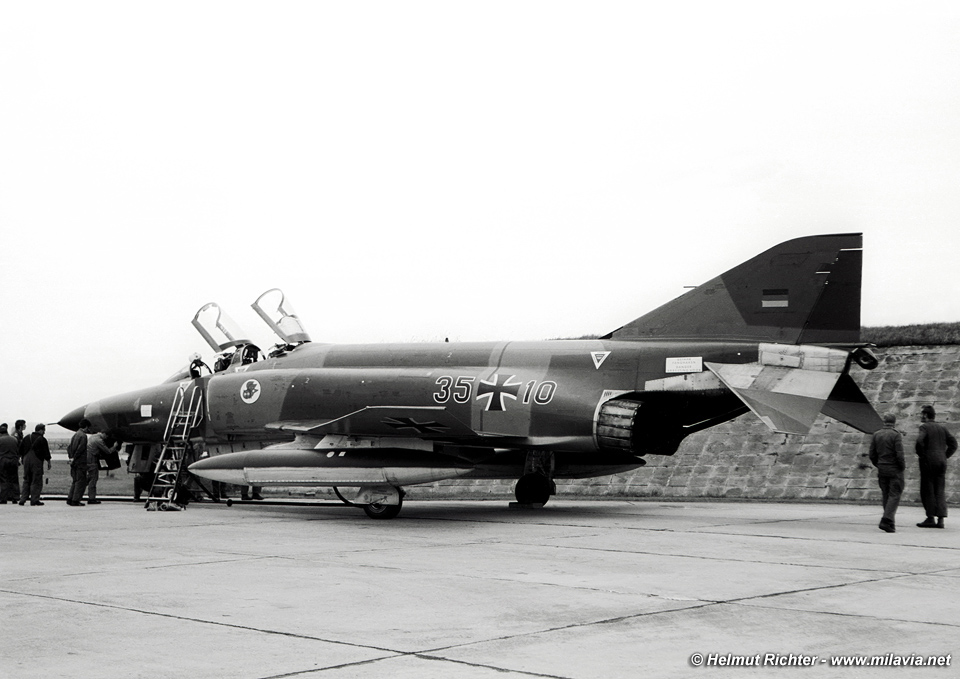- Yes
- No
I. The Luftwaffe and the Phantom
In the 1970’s, the American-designed McDonnell-Douglas F-4F Phantom II became the primary combat plane of West Germany’s Luftwaffe. The F-4F, based on the F-4E commonly employed by nearly all NATO and western aligned nations in the mid-late Cold War, was an “economy” model, with the capability to fire the semi-active radar-homing Sparrow missiles removed. This was acceptable, as the Luftwaffe’s primary mission at the time would’ve been to assist NATO forces, chiefly the United States, had the Cold War gone hot in Europe. However, it was clear by the mid-1970’s that West Germany would need to keep-up with the times, as the development of avionics sped up and modern missiles and sensor sets became exponentially more effective than ever. This need to keep up would result in West Germany’s participation in two pan-European projects for new combat aircraft: the MRCA (Multi-Role Combat Aircraft) program, and the ECF (European Combat Fighter) Program.

II. The Tornado Problem
Both the MRCA and ECF programs, despite being international collaborations with Britain, Italy and France, were enormous undertakings for the nations air industries. As these projects dragged on, the need for the Luftwaffe to be able to effectively patrol its own skies only became more dire. The MRCA program promised to help alleviate this need, as the MRCA design was to serve a dual-purpose between interdiction/strike and air-defense. In 1979, the interdiction/strike oriented design entered production as the Panavia Tornado IDS, bringing a strong combination of modern flight characteristics and smart weaponry to the arsenal of the Luftwaffe. The same could not be said of the air-defense variant, who’s prototyping dragged on due to delays with obtaining a functioning radar set. As such, for the purpose of fulfilling the increasingly dire air-defense need, the Luftwaffe turned to its fleet of Phantoms.
III. The Phantom Solution
While the Phantom in West German service was primarily a strike aircraft/fighter-bomber, the Phantom, as originally envisioned by McDonnell-Douglas in 1960, was initially a heavyweight fleet-defense interceptor for the U.S. Navy. As such, despite its current role in the Luftwaffe, and almost 25 years of evolution since the introduction of the original Phantom, it was West Germany’s best candidate for a locally designed interceptor. Therefore, in 1983, the Improved Combat Efficiency program was initiated, at first to upgrade 75 F-4F to “ICE” standards, which, due to further delays in the design of the Eurofighter Typhoon, would then total to 156 airframes upgraded. The ICE program’s upgrades focused entirely on sensors and weaponry, refurbishing existing airframes, but leaving them mostly intact save for the reduction of weight by replacing analog vacuum-tubing computers with fully digitized electronic systems. The focal points of the upgrade program would include digitizing flight systems, and installing a new, high power, look-down radar coupled with the brand-new active radar-homing AIM-120 AMRAAM missiles. The ICE upgrades were divided in three stages:
ICE Stage 1: Overhaul and Repair
‣ Airframe overhaul for a maximum of 10,000 flight-hours
‣ Extended maintenance overhaul period to 72 months
ICE Stage 2: Basic Avionic Upgrades
‣ Honeywell H-423 Laser INS (Inertial Navigation System)
‣ GEC CPU-143/A Central Air Data Computer
‣ Mil.Std. 1553R Digital Data Bus
‣ AN/ALR-68(V)-2 Radar Warning Receiver
43 F-4F’s were upgraded up to ICE Stage 2 standard, designated Luftangriff (Ground Attack), and identifiable by the black nosecone, still equipped with the original APQ-120 radar.
ICE Stage 3: Weapons Systems Upgrades
‣ Hughes-DASA AN/APG-65Y multimode radar
‣ Litef Digital Fire Control System
‣ Frazer-Nash launch system for AIM-120 (fitted in “Sparrow Slots”)
113 F-4F ICE would be upgraded to the full Stage 3 standard, identifiable by matte-grey nosecones. Over time, all ICE Phantoms would also receive general/incremental upgrades, such as the equipping of an IFF transponder. The F-4F ICE would serve Germany until 2013, by which the Eurofighter Typhoon has reached full strength in Luftwaffe service.
Sources:

IV. The F-4 ICE: Specifications
Performance
‣ Propulsion: ×2 General-Electric J79-MTU-17A afterburning turbojet
ㅤ‣ 52.8 kN max thrust/79.6 kN afterburning thrust
‣ Weight (Empty/Max): 13,755 kg/28,030 kg
‣ Speed: 1703 km/h at altitude
‣ Length: 19.2 m
‣ Wingspan: 11.7 m
‣ Height: 5.02 m
‣ Crew: Two
Sources:
Radar & RWR
Hughes-DASA AN/APG-65Y
‣ I-band
‣ ±70° azimuth/±60° elevation
‣ Range: 9 - 300 km
‣ Angle: 20/45/90/140°
‣ Multimode:
ㅤ‣ Range-While-Scan [SRC PD]
ㅤ‣ Velocity Search [SRC PDV HDN]
ㅤ‣ Track-While-Scan (TWS) [TWS PD]
ㅤ‣ Single Target Track (STT) [TRK PD]
ㅤ‣ Boresight [ACM PD]
ㅤ‣ Vertical Acquisition [ACM PD]
Litton AN/ALR-68(V)-2 ARWS (Advanced Radar Warning System)
‣ Digital system specifically designed for use in West Germany
Sources:
- Hughes AN/APG-65 radar series - Technical data and discussion - Thanks to @Acroute
- AN/APG-65 Radar System
- AN/APG-65GY - Radartutorial
- https://www.aef.se/Avionik/Artiklar/Motmedel/Nya_hotbilder/RadarWarnStory.pdf
- AN/ALQ to AN/ALT - Equipment Listing
Armaments
‣ ×1 M61A1 20 mm rotary cannon
‣ ×4 active-radar homing air-to-air missiles
ㅤ‣ AIM-120B AMRAAM
‣ ×4 IR-guided air-to-air missiles
ㅤ‣ AIM-9L
ㅤ‣ AIM-9L(I)-1 (AIM-9L with IRCCM upgrade by Diehl, roughly equivalent to AIM-9M)
ㅤ‣ IRIS-T (High performance missile: carried for testing)
‣ ×2 Air-to-ground missiles
ㅤ‣ AGM-65B Maverick
‣ ECM Pod:
ㅤ‣ ×1 AN/ALQ-131 (installed in leftmost AMRAAM slot)
ㅤ‣ ×2 SPS-141 (installed on innermost wing pylons) - Thanks to @BagelIsMyWaifu
‣ Bombs:
ㅤ‣ Mk.80 series: Mk.81/Mk.82/Mk.83/Mk.84
ㅤ‣ M117 750 lb GP bomb
ㅤ‣ M118 3,000 lb bomb
ㅤ‣ BLU-27/B napalm bomb
‣ Rockets:
ㅤ‣ FFAR Mighty Mouse
ㅤ‣ Zuni Mk.32
‣ ×3 Gunpods: SUU-23/A
ㅤ‣ GAU-4 20 mm rotary cannon
‣ Droptank: 600 gal.
Note: ground attack armament assumed to be inherited from standard F-4F and Peace Rhine upgrade
F-4 ICE Firing AIM-120B

F-4 ICE Carrying AIM-9L

F-4 ICE Carrying IRIS-T

Sources:
- Difference between AIM-9L, AIM-9L(I-1) and AIM-9M | Pakistan Defence.
- Aircraft in Detail - F-4 Phantom II Walkaround
- Aerospaceweb.org | Ask Us - German F-4F Armament
- [4.0] Phantom In Foreign Service
V. The F-4 ICE’s Place in War Thunder
In War Thunder, the F-4 ICE would represent the last hurrah of the F-4 family, an airframe which had long dominated the top ranks of the US, UK, German, Japanese and Israeli trees until the introduction of 4th generation fighters such as the F-14 and F-16. The F-4 ICE will most likely fit in Rank VIII, after the standard F-4F, at BR of 12.0-12.3. While the F-4F airframe is the best out of all Phantoms, The F-4 ICE’s flight performance will undoubtably be supbar compared to the 4th generation competition such as the F-16 and MiG-29. Therefore, the F-4 ICE’s primary advantages against its opponents will be its powerful APG-65 radar and ARH AIM-120 missiles. While the AIM-120 is not yet in game, it is assumed that lesser aircraft (in terms of performance) will be used to “ease” the missile into the game, and for this role, the F-4 ICE fits perfectly. In terms of IR missiles, standard AIM-9L’s are already quite prolific, and the AIM-9L(I)-1, Germany’s unique upgrade of the AIM-9L, will most likely fit the F-4 ICE well, especially with the introduction of the AIM-9M. The IRIS-T is also a possibility, although the missile itself remains extremely powerful and 15 to 20 years still more modern than War Thunder’s current top IR missiles, thus should be avoided unless the F-4 ICE performs extremely poorly in game. Finally, being a member of the Phantom family allows the F-4 ICE to enjoy excellent multirole capability in strike gameplay.





